regular charging MITSUBISHI iMiEV 2014 1.G Owners Manual
[x] Cancel search | Manufacturer: MITSUBISHI, Model Year: 2014, Model line: iMiEV, Model: MITSUBISHI iMiEV 2014 1.GPages: 262, PDF Size: 26.84 MB
Page 3 of 262

Instruments and controls (Driver’s area) 1-1
1
Overview
N00100202573
Instruments and controls (Driver’s area)
Wiper and washer switch P.5-48 Rear window wiper and washer switch P.5-49
Instrument cluster P.5-34
Combination headlight
s and dimmer switch
P.5-44 Turn signal lever P.5-46Front fog light switch P.5-47
Electric motor switch P.5-18
Electric remote-controlled outside mirror switch P.5-17
Active Stability Control (ASC) OFF switch P.5-29
Supplemental restraint system (SRS) - airbag (for driver’s seat) P.4-21, 4-27Horn switch P.5-50
Heated driver’s seat switch P. 4 - 4
Fuses P.9-18
Regular charging lid opener P.3-16
BK0209800US.book 1 ページ 2014年1月14日 火曜日 午前9時26分
Page 8 of 262
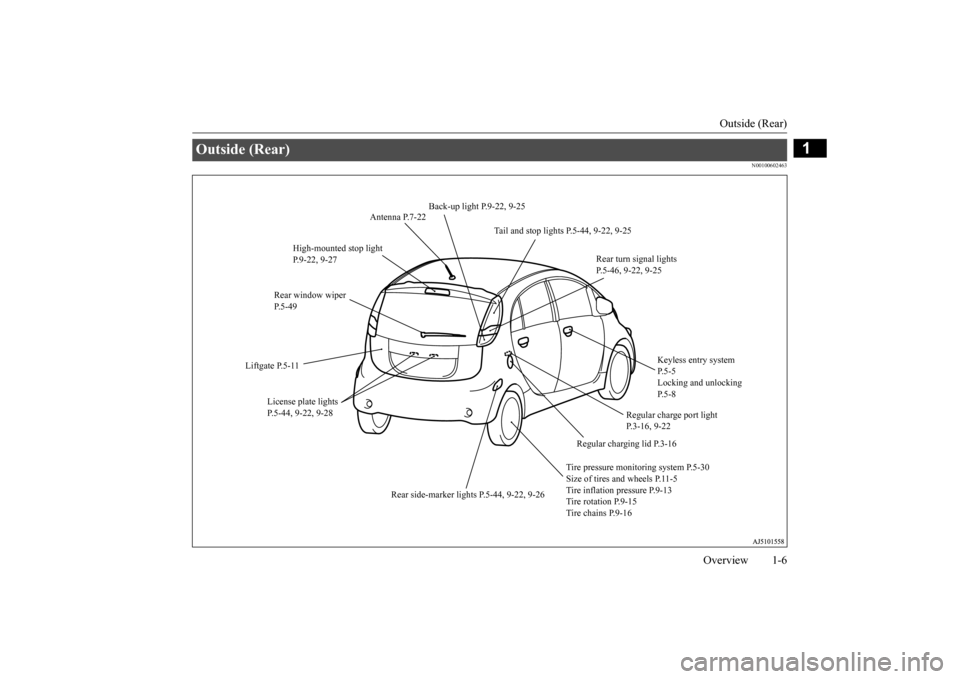
Outside (Rear)
Overview 1-6
1
N00100602463
Outside (Rear)
Back-up light P.9-22, 9-25
Antenna P.7-22
Tail and stop lights P.5-44, 9-22, 9-25
High-mounted stop light P.9-22, 9-27
Rear turn signal lights P.5-46, 9-22, 9-25
Rear window wiper P.5-49
Keyless entry system P. 5 - 5Locking and unlocking P. 5 - 8
Liftgate P.5-11
License plate lights P.5-44, 9-22, 9-28
Regular charge port light P.3-16, 9-22
Regular charging lid P.3-16 Tire pressure monitoring system P.5-30 Size of tires and wheels P.11-5 Tire inflation pressure P.9-13 Tire rotation P.9-15Tire chains P.9-16
Rear side-marker lights P.5-44, 9-22, 9-26
BK0209800US.book 6 ページ 2014年1月14日 火曜日 午前9時26分
Page 16 of 262
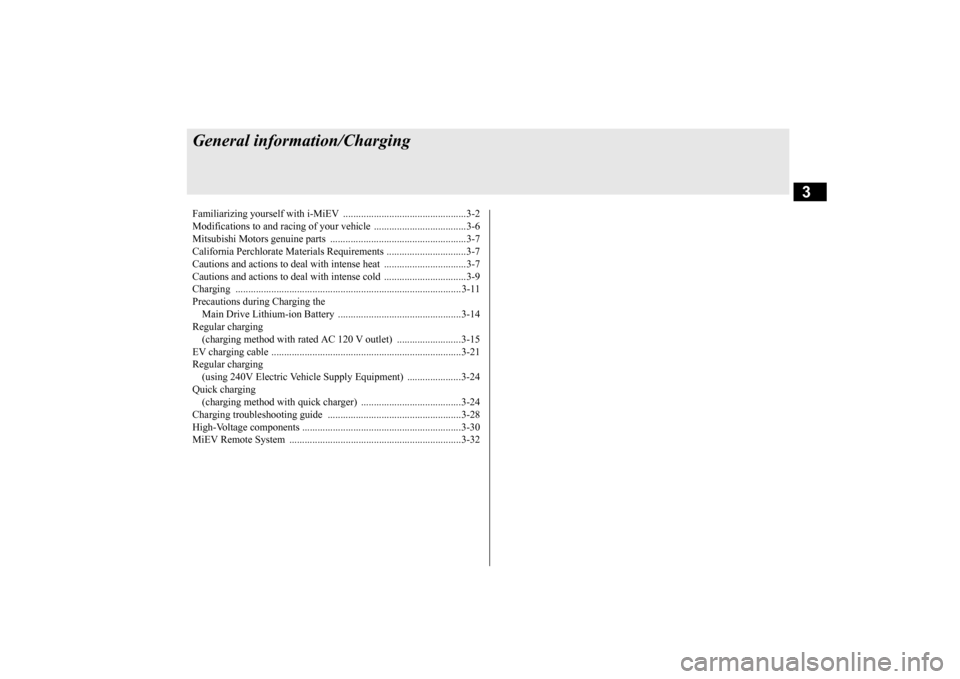
3
General information/ChargingFamiliarizing yourself with i-
MiEV ........
...........
...........
...........
.......3-2
Modifications to and racing of your vehi
cle ...........
...........
.........
.....3-6
Mitsubishi Motors genuine parts .....................................................3-7California Perchlorate Materials Requirements ...............................3-7 Cautions and actions to deal with intense heat ................................3-7 Cautions and actions to deal with intense cold ................................3-9Charging ........................................................................................ 3-11 Precautions during Charging the Main Drive Lithium-ion Battery ................................................3-14Regular charging (charging method with rated AC 120 V
outlet) .....
........
............3-15
EV charging cable ..........................................................................3-21Regular charging (using 240V Electric Vehi
cle Supply Equipment) ..
...................3-24
Quick charging (charging method with quick charger) ..
..............
.........
.........
.....3-24
Charging troubleshooting guide ....................................................3-28 High-Voltage components ......
...........
...........
...........
.........
.........
.....3-30
MiEV Remote System ...................................................................3-32
BK0209800US.book 1 ページ 2014年1月14日 火曜日 午前9時26分
Page 18 of 262

Familiarizing yourself with i-MiEV
General information/Charging 3-3
3
N01205601023
Motion energy is converted into electric energy using the motor as a power generator. While decelerating, electric energy will becreated and used to charge to the main drive lithium-ion battery. If you lift your foot off the accelerator pedal while driving, a braking force thatequivalent to the engine braking of a gas- oline or diesel powered vehicle engine vehicle will
be generate.
For increased regenerative braking, set the selector lever to “B” (REGENERATIVE BRAKE MODE) or “ECO” (ECOMODE) as follows: • “B”: Strong regenerative braking (For downhill driving)• “ECO”: Moderate regenerative braking (For economical driving or gentle down- hill driving)
As greater brake fo
rce is applied by
depressing the brak
e pedal, increased
regenerative braking occurs.
N01200300015
Keep the brake pedal depressed until you are ready to drive. When the vehicle is inthe “D” (DRIVE), “ECO” (ECO MODE),“B” (REGENERATIVE BRAKE MODE) or “R” (REVERSE) position, if you release the brake pedal and even if you donot depress accelerator, the vehicle will creep and may move slowly.
Regenerative braking
WA R N I N G
NOTE
When the main drive lithium-ion battery level is full or nearly
full, or the main drive
lithium-ion battery temperature is too high or too low, the regenerative braking force may be reduced and stronger service brake effortmay be required to operate the brakes. When the main drive lithium-ion battery level is no longer full or near full,
or the main drive lith-
ium-ion battery temperature has returned to a normal range, the regene
rative brake force
will resume. If a problem occurs in the electric motor unit, or if the ABS and/or the ASC have been acti-vated, the regenerati
ve braking will be
restricted. The service brakes will still oper- ate.
Main drive lithium-ion battery
WA R N I N G The main drive lithium-ion battery is a sealed high voltage battery and has nouser serviceable parts.
• To avoid severe burn
s and/or
electrical
shock that may result in serious injury ordeath, never attempt to detach the maindrive lithium-ion battery from the vehi- cle or try to disassemble it.• Never attempt to dispose or recycle themain drive lithium-ion battery by your- self. Consult with a certified i-MiEVdealer, when the main drive lithium-ion battery is disposed or recycled.• Never attempt to use the main drive lith-ium-ion battery for any other purpose.CAUTION To help prevent damage to the main drive lithium-ion battery, foll
ow the instructions
described below. Failure
to do so can result
in damage to the main
drive lithium-ion bat-
tery that will not
be covered by the main
drive lithium-ion battery warranty.• Do not leave your vehicle with the energylevel gauge (Refer to
“Energy level gauge”
on page 5-40) showing 0 bars.• Repeatedly performing quick charging canreduce battery capacity. Regular charging isrecommended unless quic
k charging is nec-
essary.WA R N I N G
BK0209800US.book 3 ページ 2014年1月14日 火曜日 午前9時26分
Page 19 of 262

Familiarizing yourself with i-MiEV 3-4 General information/Charging
3
N01205500012
The capacity of the lithium-ion battery used as the main drive lithium-ion battery on your i-MiEV, like other commonly used lithium ion batt
eries, will decrease
according to time and usage. This type of decrease in battery capacity is normal, and is not indicative of a
ny defect or failure in
your main drive lithium-ion battery. As the main drive lithium-ion battery capac- ity decreases, the in
itial cruising range of
the vehicle will si
milarly decrease.
Mitsubishi Motors estimates that after 5 years, the capacity of the main drive lith-ium-ion battery provided with your vehi- cle will be a
pproximately 80% of the
original capacity. Af
ter 10 years, the
capacity should be approximately 70% of the original capacity. These are only esti- mates, and the actual capacity of yourvehicle battery over
time will depend on a
variety of factors including how your vehicle is used, stored and charged. Fac- tors that can adve
rsely affect battery
capacity over time incl
ude frequent driv-
ing using aggressive
acceleration/deceler-
ation, repeated frequent use of the quick charger, and operation/storage in extremetemperature environments. The main drive lithium-ion battery has a limited service life, and when its chargingcapacity falls, owne
rs should bring their
vehicle to a certified i-MiEV dealer for inspection and possible battery replace-ment. For details regardi
ng the warranty cover-
age for the main drive lithium-ion battery,refer to the Warranty and Maintenance Manual.
N01200400016
The distance you can driv
e the vehicle (cruis-
ing range) depends on
a number of factors
including available char
ge, weather, tempera-
ture, usage, battery age, topography, and driv- ing style. When the main drive lithium-ion battery is new, the estimated cruising rangewith a fully charged main drive lithium-ion battery is 62 miles (100 km) based on the EPA laboratory test commonly called thecombined range. Your actual range can vary, either initially or as the battery ages and with use over time.As the main drive lithium-ion battery capac- ity decreases, the cruising range of the vehi- cle will similarly decrease. Refer to“Decrease of battery capacity” on page 3-4.
Do not store your vehicle at ambient temper- atures above 131 °F (55 °C) for over 24hours, or below -13 °F (-25 °C) for over 7 days. The tempera- tures may damage the
main drive lithium-ion
battery.NOTE
It is recommended that your vehicle be stored at temperatures below 77 °F (25 °C)to help maximize the life of the main drive lithium-ion battery.
Decrease of battery capacity
CAUTION
NOTE
To help maintain the capacity of the main drive lithium-ion batter
y, the following are
recommended:
• Fully charge the vehicle by regular charg-ing every 2 weeks. • Do not repeat charging when the main drive lithium-ion battery is at
or near full charge.
Cruising range
NOTE
Since cooling or he
ating consumes power
from the main drive lithium-ion battery,operation of these functions will reduce the cruising range.NOTE
BK0209800US.book 4 ページ 2014年1月14日 火曜日 午前9時26分
Page 23 of 262
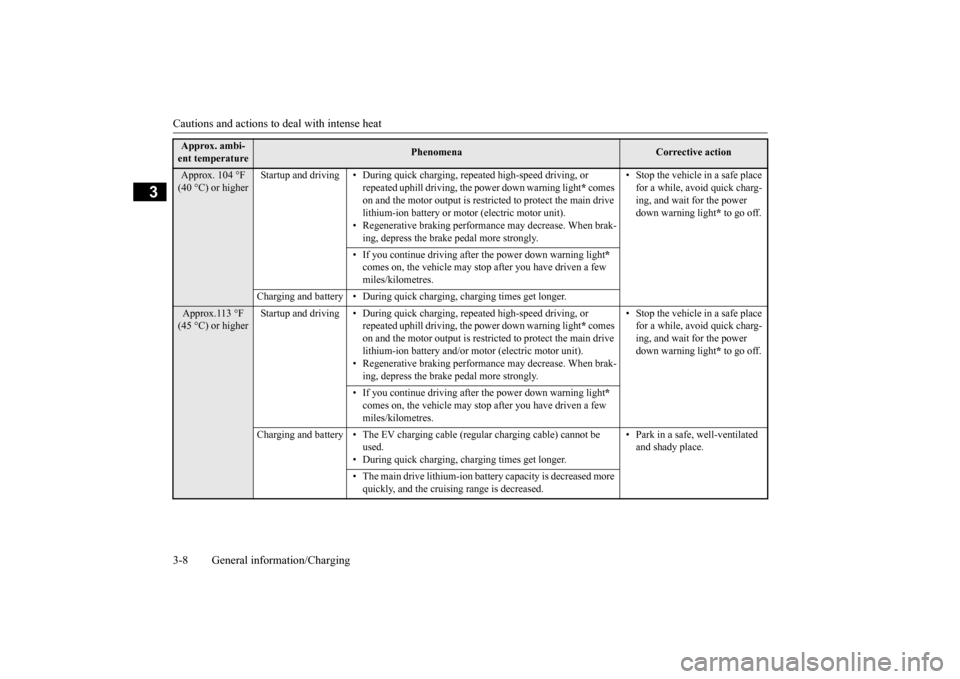
Cautions and actions to deal with intense heat 3-8 General information/Charging
3
Approx. ambi- ent temperature
Phenomena
Corrective action
Approx. 104 °F (40 °C) or higher
Startup and driving •
• During quick charging, repeated high-speed driving, or repeated uphill driving,
the power down warning light
* comes
on and the motor output is restrict
ed to protect the main drive
lithium-ion battery or mo
tor (electric motor unit).
Regenerative braking performance
may decrease. When brak-
ing, depress the brake pedal more strongly.
• Stop the vehicle in a safe place for a while, avoid quick charg- ing, and wait for the power down warning light
* to go off.
• If you continue driving after the power down warning light
*
comes on, the vehicle may stop
after you have driven a few
miles/kilometres.
Charging and battery • During quick
charging, charging times get longer.
Approx.113 °F (45 °C) or higher
Startup and driving •
• During quick charging, repeated high-speed driving, or repeated uphill driving,
the power down warning light
* comes
on and the motor output is restrict
ed to protect the main drive
lithium-ion battery and/or motor (electric motor unit). Regenerative braking performance
may decrease. When brak-
ing, depress the brake pedal more strongly.
• Stop the vehicle in a safe place for a while, avoid quick charg-ing, and wait for the power down warning light
* to go off.
• If you continue driving after the power down warning light
*
comes on, the vehicle may stop
after you have driven a few
miles/kilometres.
Charging and battery •
• The EV charging cable (regular charging cable) cannot be used. During quick charging, ch
arging times get longer.
• Park in a safe, well-ventilated and shady place.
• The main drive lithium-ion batt
ery capacity is decreased more
quickly, and the cruisi
ng range is decreased.
BK0209800US.book 8 ページ 2014年1月14日 火曜日 午前9時26分
Page 24 of 262
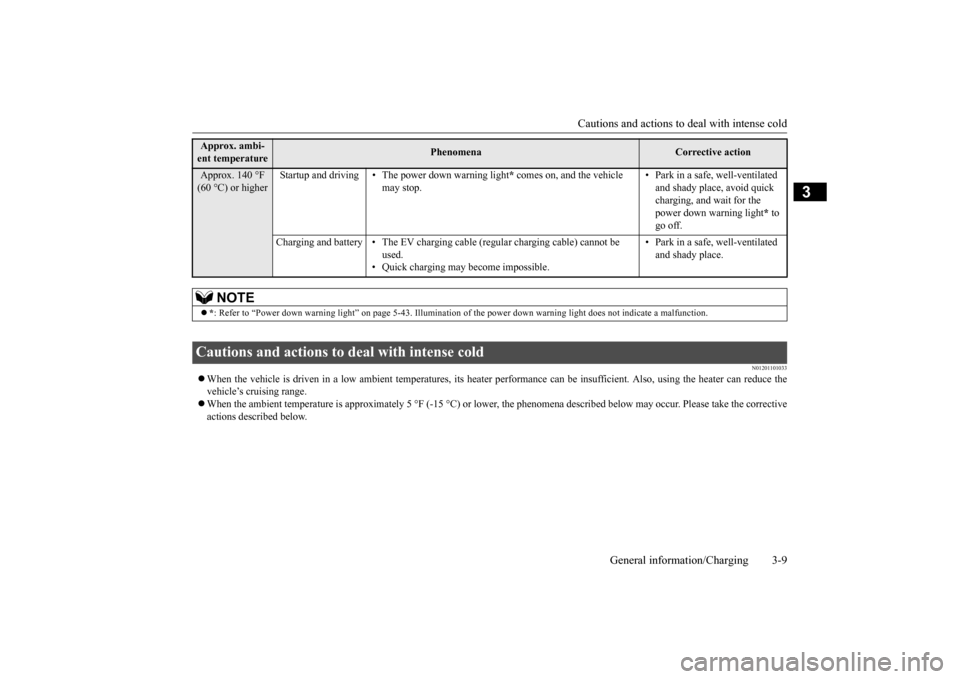
Cautions and actions to deal with intense cold
General information/Charging 3-9
3
N01201101033
When the vehicle is driven in a low ambient temperatures, its he
ater performance can be insuffic
ient. Also, using the heater ca
n reduce the
vehicle’s cruising range. When the ambient temperature is approximate
ly 5 °F (-15 °C) or lower, the phenomena de
scribed below may occu
r. Please take the
corrective
actions described below.Approx. 140 °F (60 °C) or higher
Startup and driving • The power down warning light
* comes on, and the vehicle
may stop.
• Park in a safe, well-ventilated and shady place,
avoid quick
charging, and wait for the power down warning light
* to
go off.
Charging and battery •
• The EV charging cable (regular
charging cable) cannot be
used.Quick charging may become impossible.
• Park in a safe, well-ventilated and shady place.
NOTE
*: Refer to “Power down warning light” on pa
ge 5-43. Illumination of the power down wa
rning light does not i
ndicate a malfunctio
n.
Cautions and actions to deal with intense cold Approx. ambi- ent temperature
Phenomena
Corrective action
BK0209800US.book 9 ページ 2014年1月14日 火曜日 午前9時26分
Page 27 of 262
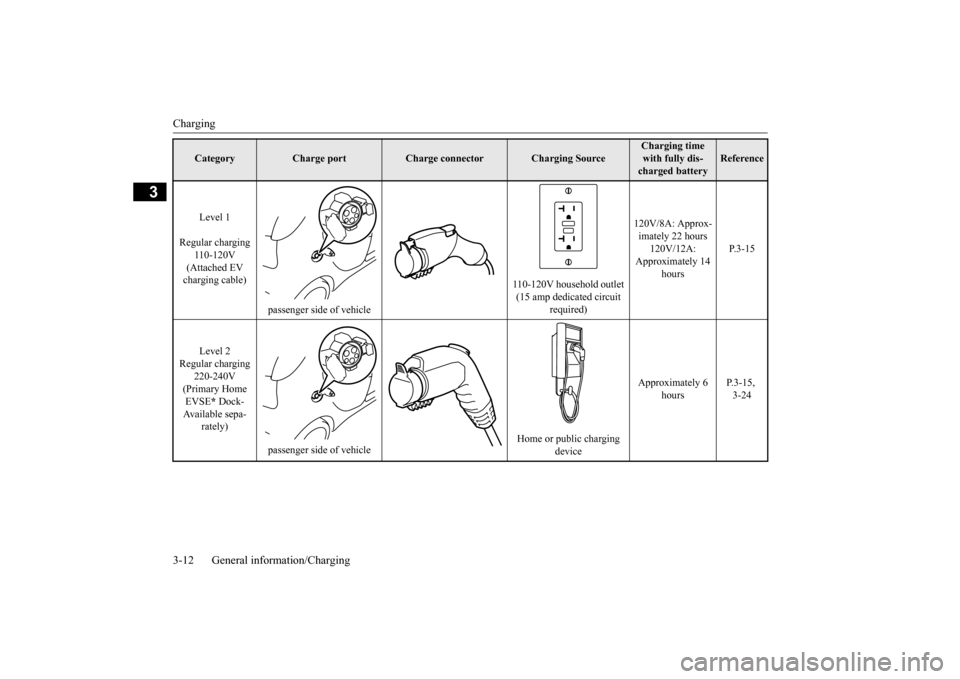
Charging 3-12 General information/Charging
3
Category
Charge port
Charge connector
Charging Source
Charging time with fully dis- charged battery
Reference
Level 1
Regular charging
110-120V (Attached EV charging cable)
passenger side of vehicle
110-120V household outlet (15 amp dedicated circuit
required)
120V/8A: Approx- imately 22 hours
120V/12A:
Approximately 14
hours
P.3-15
Level 2
Regular charging
220-240V(Primary Home EVSE
* Dock-
Available sepa-
rately)
passenger side of vehicle
Home or public charging
device
Approximately 6
hours
P.3-15, 3-24
BK0209800US.book 12 ページ 2014年1月14日 火曜日 午前9時26分
Page 28 of 262
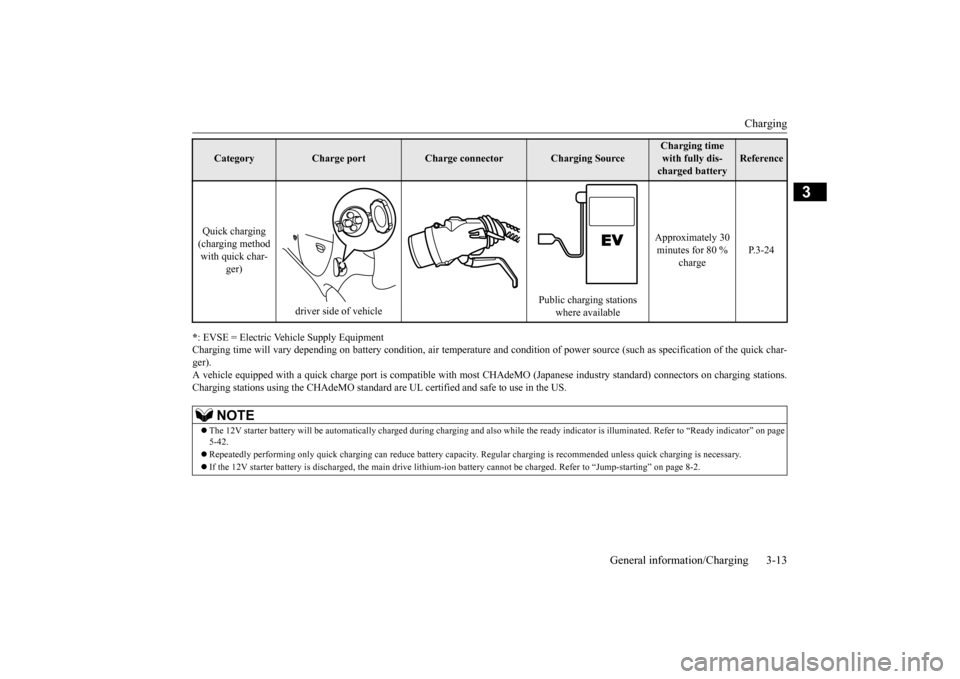
Charging
General information/Charging 3-13
3
* : EVSE = Electric Ve
hicle Supply Equipment
Charging time will vary
depending on battery condition,
air temperature and condition of power
source (such as specification of
the quick char-
ger). A vehicle equipped with a
quick charge port is compatible with most CHAdeM
O (Japanese industry standa
rd) connectors on charging
stations.
Charging stations using the CHAdeMO standard ar
e UL certified and safe to use in the US.
Quick charging (charging method with quick char-
ger)
driver side of vehicle
Public charging stations
where available
Approximately 30 minutes for 80 %
charge
P. 3 - 2 4
NOTE
The 12V starter battery will be automatica
lly charged during charging and
also while the ready indicator is illuminated. Refer
to “Ready indicator” on page
5-42. Repeatedly performing only quick charging ca
n reduce battery capacity. Regular chargi
ng is recommended unless quick charging is
necessary.
If the 12V starter battery is di
scharged, the main drive lithium-ion battery cannot
be charged. Refer to “Jump-starting” on pag
e 8-2.
Category
Charge port
Charge connector
Charging Source
Charging time with fully dis- charged battery
Reference
BK0209800US.book 13 ページ 2014年1月14日 火曜日 午前9時26分
Page 29 of 262
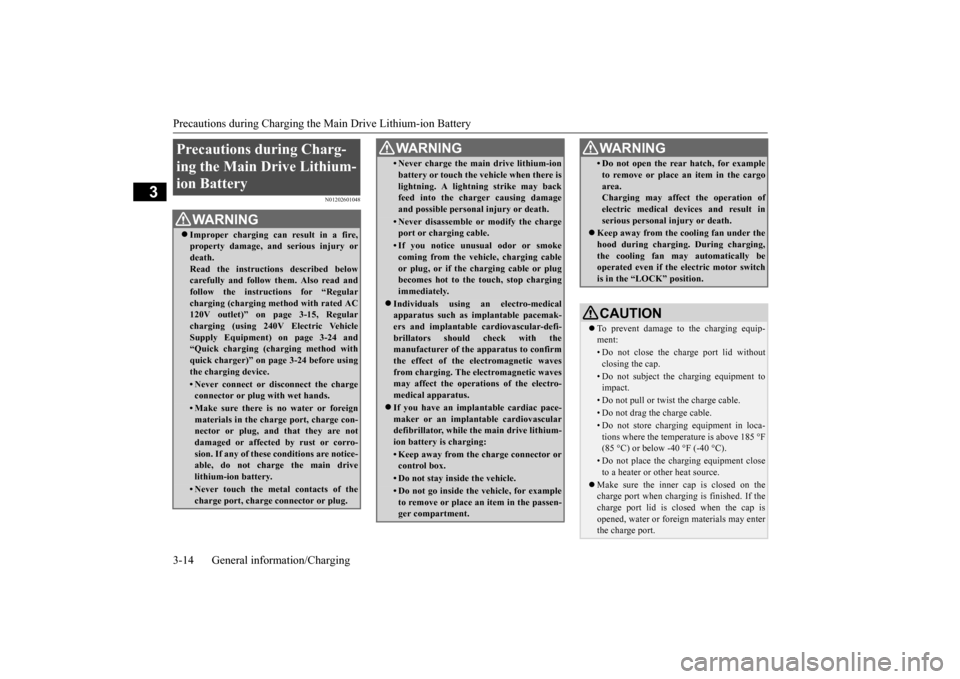
Precautions during Charging the
Main Drive Lithium-ion Battery
3-14 General information/Charging
3
N01202601048
Precautions during Charg- ing the Main Drive Lithium-ion Battery
WA R N I N G Improper charging can result in a fire, property damage, and serious injury ordeath. Read the instructions described below carefully and follow
them. Also read and
follow the instructions for “Regular charging (charging me
thod with rated AC
120V outlet)” on page 3-15, Regularcharging (using 240V
Electric Vehicle
Supply Equipment)
on page 3-24 and
“Quick charging (c
harging method with
quick charger)”
on page 3-24 before using
the charging device.• Never connect or disconnect the chargeconnector or plug with wet hands.• Make sure there is no water or foreignmaterials in the char
ge port, charge con-
nector or plug, and that they are notdamaged or affected by rust or corro- sion. If any of these conditions are notice- able, do not charge
the main drive
lithium-ion battery.• Never touch the metal contacts of thecharge port, charge
connector or plug.
• Never charge the main drive lithium-ion battery or touch the vehicle when there islightning. A lightning strike may backfeed into the char
ger causing damage
and possible personal
injury or death.
• Never disassemble or modify the charge port or charging cable.• If you notice unus
ual odor or smoke
coming from the vehi
cle, charging cable
or plug, or if the ch
arging cable or plug
becomes hot to the touch, stop charging immediately.
Individuals using an
electro-medical
apparatus such as implantable pacemak- ers and implantable
cardiovascular-defi-
brillators should
check with the
manufacturer of the apparatus to confirm the effect of the el
ectromagnetic waves
from charging. The el
ectromagnetic waves
may affect the operations of the electro- medical apparatus. If you have an impl
antable cardiac pace-
maker or an implan
table cardiovascular
defibrillator, while the main drive lithium- ion battery is charging:• Keep away from the charge connector orcontrol box.• Do not stay inside the vehicle.• Do not go inside the
vehicle, for example
to remove or place an item in the passen- ger compartment.WA R N I N G
• Do not open the rear hatch, for example to remove or place an item in the cargoarea.Charging may affect
the operation of
electric medical devices and result in serious personal
injury or death.
Keep away from the cooling fan under the hood during charging. During charging,the cooling fan may automatically be operated even if the electric motor switch is in the “LOCK” position. CAUTION To prevent damage to the charging equip- ment:• Do not close the charge port lid withoutclosing the cap.• Do not subject the charging equipment toimpact.• Do not pull or twist the charge cable.• Do not drag the charge cable.• Do not store charging equipment in loca-tions where the temperature is above 185 °F (85 °C) or below -40 °F (-40 °C).• Do not place the charging equipment close to a heater or other heat source.
Make sure the inner
cap is closed on the
charge port when charging is finished. If the charge port lid is closed when the cap is opened, water or forei
gn materials may enter
the charge port.WA R N I N G
BK0209800US.book 14 ページ 2014年1月14日 火曜日 午前9時26分